In this article, you will learn what is a differential system? and how they work? Its component and types of differential are explained in detail with diagrams. you can also download the PDF file of this article at the end of it.
What is Differential?
If you ever played with a toy car, then you know it moves well in a straight line but it doesn’t take a turn. This is because it doesn’t have a differential. But, your vehicle makes turns on corners, whether it’s front, rare, four, or all-wheel-drive.
A differential is defined as a gear train, which consists of three gears that feature the rotational speed of one shaft is the average speed of the others, or a fixed multiple of that average.
The differential is a set of gears, that transfers engine torque to the wheels. It takes power from the engine and delivers it, allowing each wheel to rotate at a different speed on turns.
In 1827, the first conventional automobile differential was invented by a French watchmaker Onésiphore Pecqueur. It was used in steam-powered vehicles.
Vehicles such as chariots, wagons, and carriages still suffer from wheel slipping and dragging, resulting in damage to the wheels, axles, and roads. To prevent this from happening, a differential was invented.
Read Also: 19 Amazing Car Body Styles That You Should Know
Why Differential Is Needed?
The differential allows the steering wheels to turn at different speeds so the car can take turns without putting much pressure on tires. The inside wheels move in a short distance compared to the outer wheels.
If the axle does not allow the wheels to spin freely, the wheel of the tire will drag on the ground. Hence this is essential when the vehicle turns, causing the wheel to move outside the turning curve to roll further and faster than the other.
Parts of Differential
Following are the parts of the differential system:
- Differential side gear or sun gears
- Pinion shaft or cross pin
- Axle shafts or half shafts
- Ring gear or crown wheel
- Drive pinion or bevel pinion
- Differential pinions or planet gears
- Differential case or Housing
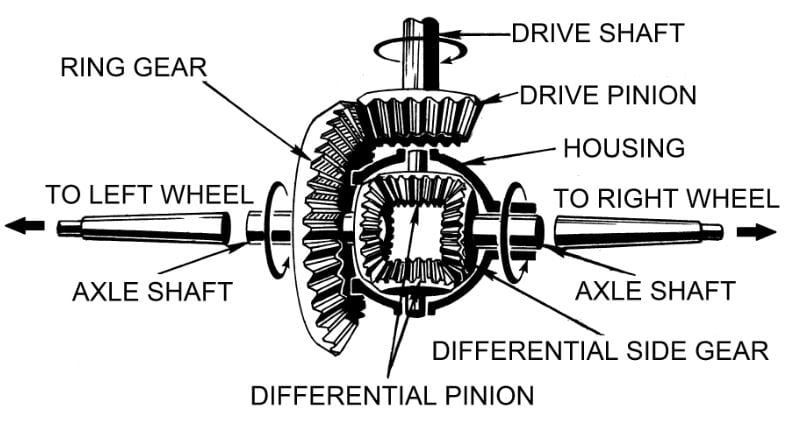
#1 Differential Side Gear or Sun Gears
The differential is consists of a small bevel gear called differential side gear or sun gear. It is mounted on the inner ends of each axle. In this, two bevel gears are fixed together to combine both the driving and driven shafts at 90° angles.
#2 Pinion Shaft or Cross Pin
There are two pinion gears and their supporting shaft is called the pinion shaft. It is fitted in the differential case.
#3 Axle Shafts or Half Shafts
An axle shaft is a solid shaft that is located between the differential and gear set of an axle housing. It transfers rotational force from the transmission system to the wheels attached to the axles.
#4 Ring Gear or Crown Wheel
The ring gear is also known as a crown wheel. They act as an equalizer in dividing the torque between the two driving wheels while allowing one to turn faster than the other.
#5 Drive Pinion or Bevel Pinion
The drive pinion is also known as bevel pinion. It is assembled with a differential housing called a differential case or carrier.
The driver shaft is connected to the drive pinion by a universal joint and it engages with a ring gear. Therefore, when the driver rotates the shaft the drive pinion rotates, and thus, the ring gear rotates.
#6 Differential Pinions or Planet gears
Planetary gears are used in the differential. Since the axles of the planetary gears rotate around the common axis of the sun and ring gear that coincides and rolls in the middle of the differential system.
#7 Differential Case or Housing
A differential case is attached with two-wheel axles and differential side gears. It is consists of bearings that rotate two axle shafts.
How Differential Works?
The power from the engine is transferred to the ring gear through a pinion gear. The ring gear is connected to a spider gear, which is at the heart of the differential system. The spider gear is free to rotate in two different ways, one along with the ring gear and two on its own axis.
The spider gear meshes with two side gears, so power from the engine flows from the pinion to the left and right wheels. Let’s consider some cases.
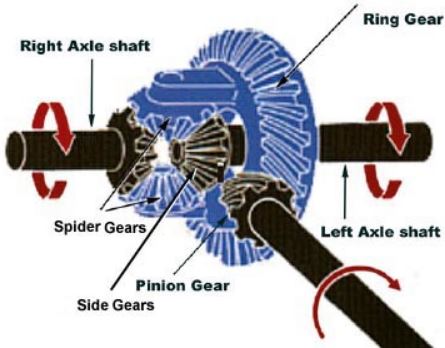
The vehicle moves straight: In this case, spider gear rotates along with the ring gear but it does not rotate on its own axis. Spider gear will push and make the side gears turn, and both will turn at the same speed.
The vehicle is taking a turn: Spider gear plays an important role here. Along with the rotation of the ring gear, it rotates on its own axis. So the spider gear is having a combined rotation.
When properly meshed side gear should have the same peripheral velocity as that of the spider gear. When the spider gear is spinning as well as rotating, peripheral velocity as the left side of spider gear is the sum of spinning and rotational velocities.
But on the right side, it is a difference between the two. Or left side gear will have higher speed compared to the right side gear. This is how the differential manages to turn the left and right wheels at different speeds.
Read Also: What is the function of the crankshaft in a vehicle?
Types of Differential
Following are the types of differential:
- Open differential
- Limited-slip differential
- Mechanical limited-slip differential
- Viscous limited-slip differential
- Active differential
- Locking differential
- Torque-vectoring differential
- Torsen differential
- Welded differential
1. Open Differential
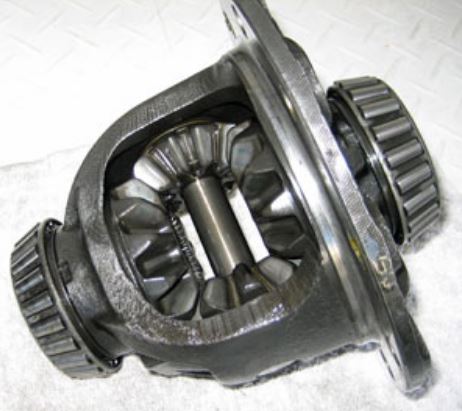
These types of differences are the most common that are easily found in passenger cars. It only allows individual wheel speed or slips to be changed. In good road conditions, this allows the outer wheel to spin at a faster speed than the inner wheel.
The problem occurs when road conditions are not good such as on wet, snow, ice, or sand. Using an open differential in your car, engine torque is transferred even though the wheel has zero traction so that the sliding tire can spin freely.
Open differentials are found in many cars on the road today, so the cost of repairing the differential is less than other types.
| Advantages of Open Differential | Disadvantages of Open Differential |
|---|---|
| This allows for different wheel speeds on the same axle, which means there will be no wheel slip when going around a corner, as the outer tire will travel further. | When traction is reduced in one wheel, it substantially limits the amount of power produced by the vehicle. If one wheel cannot dissipate as much power, the other will receive an equally small amount of torque. |
| From an efficiency point of view, there will be less energy loss through differential than other types. |
2. Limited-slip Differential
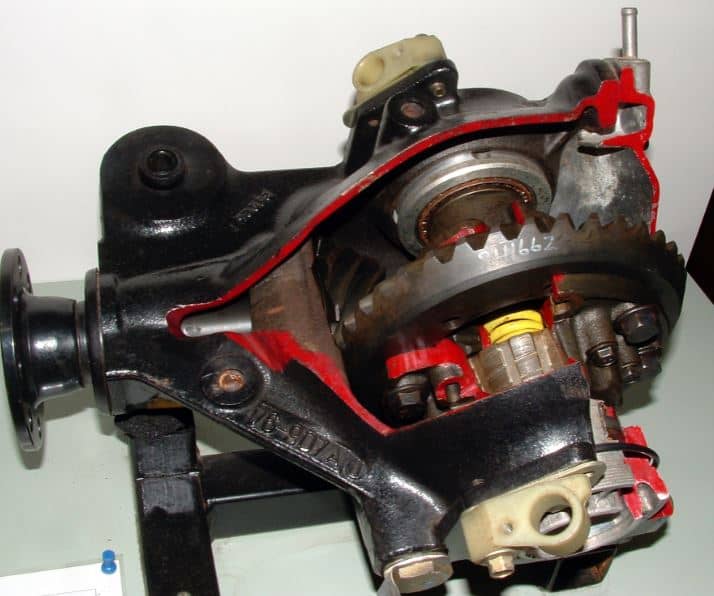
A limited-slip differential works similarly to an open differential. They transfer torque to each wheel independently under good road conditions.
An open differential can cause the tire to slip under hard cornering or heavy acceleration. But a limited-slip differential prevents the amount of torque from passing into the sliding tire (the one with the least resistance).
This is done by the use of clutches and plates within the differential. This allows the vehicle to power through corners whereas a vehicle with an open differential cannot. Race cars, off-road vehicles, and other performance vehicles use a limited-slip differential.
| Advantages of Limited-slip Differential | Disadvantages of Limited-slip Differential |
|---|---|
| This allows for different wheel speeds on one axle, thus reducing tire wear compared to a locked differential. | It cannot lock completely because the system requires a speed difference between the two sides to transfer torque. |
| It also allows the wheel to send torque with more traction. | When it is being used too often, the effect of LSD will be reduced. |
| It offers a very smooth operation, doesn’t have the low-speed clunkiness typically associated with other LSD types that navigate a tight area. |
#3 Viscous Limited-slip Differential
It is a type of limited-slip differential, it uses a thick liquid to create the necessary resistance to change the behavior of the differential between open and closed. Compared to mechanical LSD, it has fewer parts which becomes an advantage.
When a wheel spins the viscous fluid heats up and gives additional resistance. The effect of this slows the spinning wheel and diverts the torque to the wheel with grip. VLSDs are able to produce torque more effectively to the wheel that has more traction.
#4 Mechanical Limited-slip Differential
The mechanical limited-slip differential provides resistance to the free rotation of the wheels, changing the impact of the differential from open to locked and delivering it with increased traction. This type can work with one-way, 1.5-way, two-way, and even electronic.
#5 Active Differential
The active differential uses a certain mechanism to provide the required resistance for transferring the torque from one side to another. These are activated electronically instead of depending on mechanical force.
It is capable of using electronics to change the mechanical forces of the system by changing driving conditions, thus making them programmable and further controllable. Using a series of sensors throughout the vehicle, a computer can automatically detect which drive wheels require power and when.
It offers greater agility, better handling with exceptional traction. It balances for the varying rotational speed of the rear wheels, especially on curves.
#6 Locking Differential
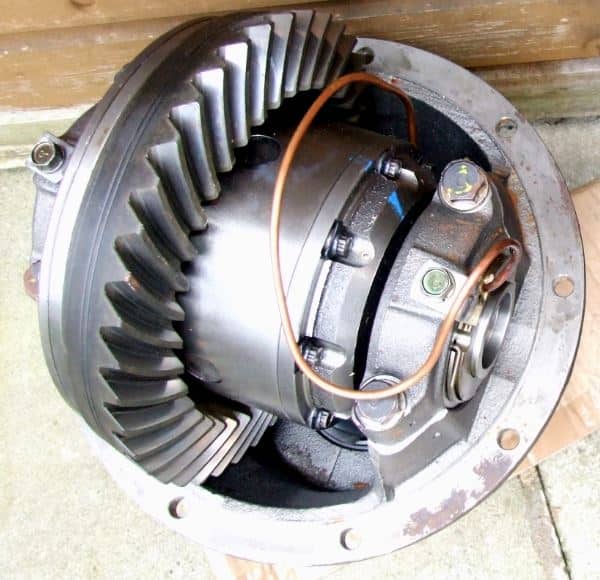
These types of differential use a clutch and springs to actuate the lock which sends the same amount of power to each wheel, no matter the traction condition. It essentially forms a solid axle.
The advantage is the locking differential ability to achieve a greater amount of traction because the full amount of torque is always available to one wheel and is not limited by the lower traction of a single wheel.
At higher speeds this is a drawback but when off-roading or rock climbing, it is a huge advantage. They are found on many off-road vehicles and some performance cars.
| Advantages of Locking Differential | Disadvantages of Locking Differential |
|---|---|
| This can provide torque to move up to the wheel with more traction. In various designs, this will allow most of the torque to reach the ground at any given surface condition. | One drawback of the locking differential is that it would not allow for a difference in wheel speed between the right and left wheels. That means additional tire wear, as well as tying up within the drivetrain as a result. |
| It is robust, simple, and very effective. | |
| It provides a solution for drifting situations where it is desirable to keep the wheel speed constant on the axle. |
#7 Torque-vectoring Differential
This type of differential uses a set of sensors and electronics to receive data from various matters (road surface, throttle position, steering system, etc.) to activate an electronically actuated clutch and a controller.
They operate in the most efficient manner resulting in a truly dynamic, high-performance driving experience. A torque-vectoring difference is found in high-performance rear-wheel drive and all-wheel drive vehicles.
| Advantages of Torque-vectoring Differential | Disadvantages of Torque-vectoring Differential |
|---|---|
| This allows the outer wheel to send more torque as it gets closer to the turn. | Though it does not have any drawbacks, it hits two things which are cost and complexity. |
| It enables complete control by the designer, the system can choose under what conditions the vehicle will send more torque to any one wheel rather than being reactive. | |
| It can send up to 100% of the potential torque to a wheel. |
#8 Torsen Differential
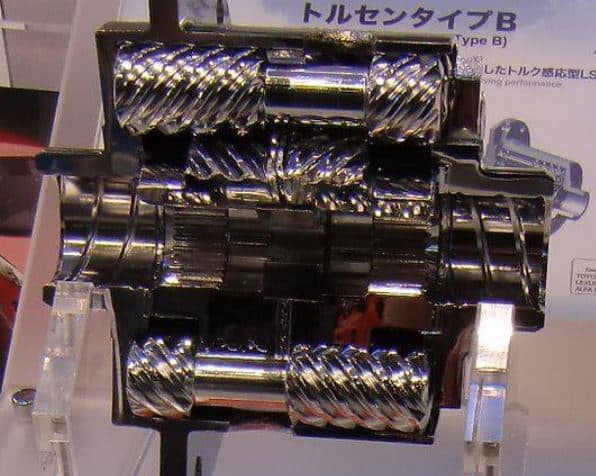
The Torsen means torque-sensing. These are types of limited-slip differential that use some accelerated gearing to produce an impact without using a clutch or fluid resistance.
This can be achieved by adding a collection of worm gears to a conventional gear setup of the open differential. These worm gears working on each axle provide the necessary resistance to enable torque transfer.
This is achieved by having the worm gears in a continuous mesh with each other through connected spur gears. The continuous mesh between the two sides of the differential has the advantage of delivering quick torque, making it sensitive to changing road and driving conditions.
| Advantages of Torsen Differential | Disadvantages of Torsen Differential |
|---|---|
| As soon as there is a speed difference between them, it starts sending more torque to the slower wheel. Also, it reacts far more quickly than LSD. | When a wheel is in the air, a Torsen differential works similar to an open differential, and very little torque is transferred to the drive axle. This is perfectly acceptable for road use, but it can be an issue for more purpose-built vehicles on the track. |
| These systems do not require regular maintenance because differential action is dependent on friction throughout the gear. |
#9 Welded or Spool differential
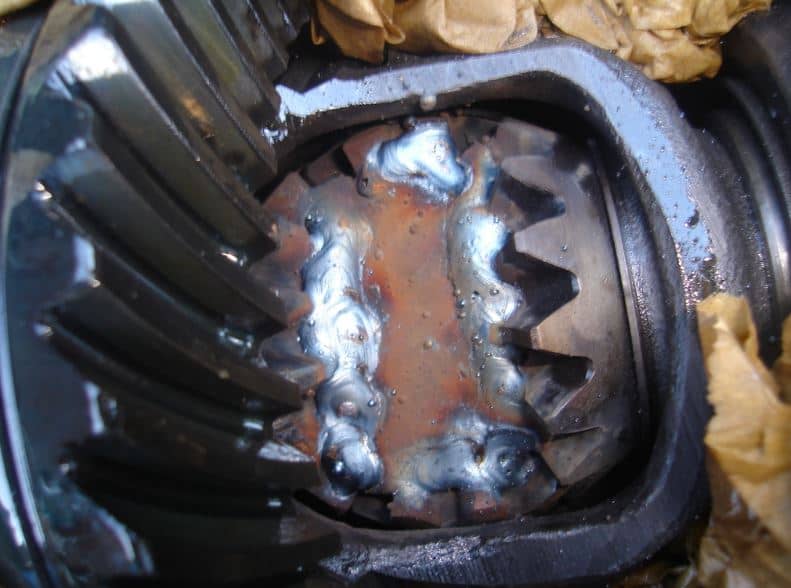
This is a type of locked differential and is known as a spool differential. It is welded permanently to a fixed axis by an open gap. This is usually done in specific situations where the features of locked differential make it easier for both wheels to spin simultaneously.
This is generally not recommended because the heat from welding can hazard the component’s strength and increase the risk of part failure.
Wrapping It Up
As far we discussed, the differential is used to drive a pair of wheels while providing them to rotate at different speeds. This mainly gives proportional RPM between the left and right wheels.
So now, I hope I’ve covered everything about the Differential and Types of Differential. If you have any questions or doubts about this article, you can ask in the comments. If you liked this article, then please share it with your friends.
Subscribe to our newsletter to be notified when we upload new posts.
Download PDF of this article:
You may like to read more interesting articles in our blog:
- 9 Different Types of Clutches and How they Work?
- Types of Gearbox: Parts, Function, Working principle, Diagram [PDF]
- Types of Steering System That Every Automobile Engineers Should know
Resources:
Please I need pdf
The PDF file has been send to your inbox.
I want this PDF to my email
The PDF file has been sent to your inbox.
Yes, please I want a PDF of this note
The PDF file has been sent to your inbox.
i need the notes to my email
The PDF file has been sent to your inbox.
I would like to have this pdf
The PDF file has been sent to your inbox.
I need this pdf in my Gmail
The PDF file has been sent to your inbox.
Love this post regarding automobiles. Thanks for sharing.
You’re welcome. Keep visiting 😉
I need this pdf its really good
I’m glad you liked it. The PDF file has been sent to your inbox.
Please sand me pdf file in my email id [email protected]…………!!!!
The PDF file has been sent to your inbox.
Please send me pdf
Email – [email protected]
The PDF file has been sent to your inbox.
May I have this pdf
The PDF file has been sent to your inbox.
I want this PDF file.
The PDF file has been sent to your inbox.
Wish to have this pdf
The PDF file has been sent to your inbox.
I need this pdf
The PDF fine has been sent to your inbox.
Please I’ll like to have this pdf
The PDF file has been sent to your inbox.
Can i get the pdf file to
The PDF file has been sent to your inbox.
👍👍
its a good lesson .I need this pdf
The PDF file has been sent your inbox.
I need PDF send me
I have sent you the PDF file to your inbox.
I wish to read this documentary regularly. …if you have a pdf, i could wish to have one.
Thanks for reading. I have sent you the PDF file to your inbox.
Please send
The PDF file has been sent to your inbox.
Please send me
I have sent you the PDF file to your inbox.
Pls send me this pdf
The PDF file has been sent to your inbox.
need pdf
I have sent the you the PDF file to your inbox.
I need the pdf
I have sent the PDF file to your inbox.
need pdf
I have sent the PDF file to your inbox.
Send me
I have sent you the PDF file in your email.
Thank you so much appreciate it.
It really helps me more informative. Learning engineer is pretty interesting. Easily understanding specific problem and work precisely.
Keep up!
Thank you so much for reading.
I wish to have this pdf document in my email
I just sent you the PDF file to your inbox.
Please I need the pdf
I have sent you the PDF file to your inbox.